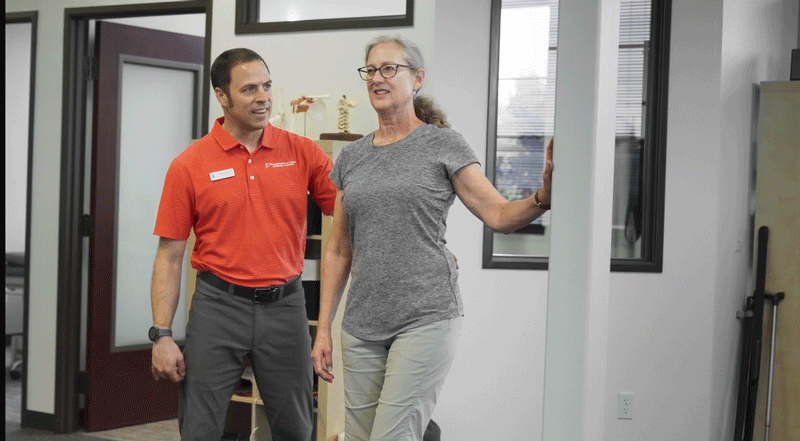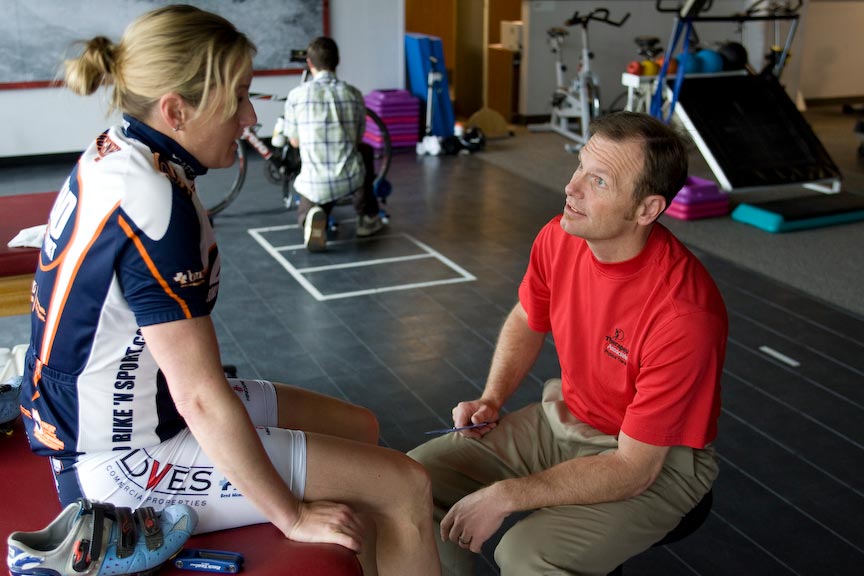Understanding and addressing pain from a neurological standpoint can be a valuable part of any physical therapy journey. As a PT with a specialty in pain neuroscience, I think it’s critical that we have a better understanding of what pain in is in our bodies as well as how we can utilize that understanding of pain to move through painful episodes or even just have less concern about pain we experience in our bodies.
One of the challenges with our modern interpretation of pain is that for the past 50 or 60 years, we’ve seen pain as an issue of tissue damage.
And so, a lot of medical interventions have zeroed in on the idea that if we can fix what’s going on in those tissues, then everything will be better. However, we know from people who experience chronic pain despite the many interventions they’ve pursued with medicine or surgeries or other therapies, sometimes this is completely wrong. In these cases, they just are not getting better.
A pain neuroscience approach to physical therapy can really inform people about what pain is and how it is affecting them.
Truly, pain is an output of the brain. By dedicating some energy to helping patients understand that, and offering educational intervention, then our hope is that we are helping them recognize when to be worried about pain, and when not to be worried about pain.
I work a lot with patients on what we call a “green, yellow, red scale.” This three-tiered scale significantly simplifies the traditional 0-10 pain scale that people have become accustomed to.

Green, which would be classified as anywhere in the zero to three range, means GO – this is not something to worry too much about. Quite often it could just be an early warning from the brain that it’s worried about something and often it’s a past injury that’s speaking because there’s a memory of having an issue.
The yellow zone is pain that you might call a four or five out of 10. We think about this like the yellow light when you’re driving – you want to slow down a little bit and use some caution. Take a little time to think about what you are feeling. If you are out there skiing or biking or even just walking around Costco and your pain is in that yellow zone, I would really encourage you to consider what you could be doing differently in your activity. And take a break. Maybe sit down for a minute. Grab a cart to lean on as you shop. But, at this level the pain is not something where you need to immediately be worried that what you’re doing is causing tissue damage.
It is when we get into that red zone, which is 6 out of 10 and up, that it is probably time to seek help.
Utilizing a pain neuroscience approach to physical therapy.
A painful brain is often a very scared brain or very fearful brain, and a pain neuroscience approach to physical therapy is going to take that into account.
Sometimes when something is wrong, we think about movement as a test to determine what the issue is. However, for some patients, just thinking about reaching their arm overhead or moving their ankle can cause a pain sensation. This is where a PT trained in pain neuroscience has additional tools in their toolbox to help those patients progress through those early stages where pain is so severe.
But in the beginning, specifically when a patient is experiencing any kind of severe pain, it is a much slower approach. The physical therapy journey begins with a lot more education, a lot more discussion, and a lot of problem solving. It doesn’t look a lot like typical PT.
In some cases, this approach continues for multiple visits, and it may be the fifth or sixth appointment before there is any physical touch during treatment.

And then what’s neat is as patients graduate through those stages, we start to see the more typical PT approaches take place as well. And so, we do get into the bigger movements and exercise and manual therapies and things like that.
It is powerful for people who have had such severe pain for so long begin to experience change in their situation and in their functionality. It is incredibly rewarding as a physical therapist to be able to facilitate that healing.
When to seek a specialist.
If you’re consistently getting into the red zone, from a pain neuroscience perspective, really what’s happening is you could be educating your brain that a certain kind of movement is dangerous.
When this happens, you’re just reinforcing some learning, such as “Every time I go for a walk I’m going to have this red zone pain,” or “Every time I go for a swim, I’m going to have this red zone pain.”
Usually that’s when it is advisable to seek help from a physical therapist with some pain neuroscience training who can help you understand what it means to be moving in that red zone and why it’s probably not useful.
Quite often, people who have had a lot of severe or chronic pain have failed traditional PT, but not because there was anything wrong with the therapy they received, it just was not right for them in that moment.
Physical therapists are musculoskeletal experts who have the education and experience to diagnose injuries and to uncover the root of the problem. If the conclusion is made that there is pain in the absence of any real tissue damage, treatment remains valuable, but is directed at the pain itself rather than focusing on helping to heal a physical injury. Typically, the course of care in these situations will include pain education combined with more traditional treatment, including manual therapy and prescribed exercise.

Don't let pain keep you down.
As physical therapists, we know the importance of movement for overall health and well-being. From injury recovery to achieving optimal performance, our passion is to help every patient reach their goals and live an active, pain-free life. Get started with PT today!

